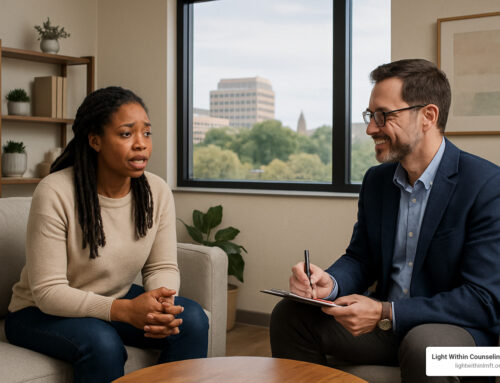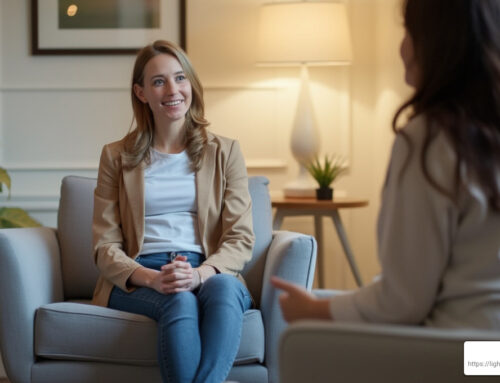Health Anxiety

A quick search was supposed to bring peace of mind but instead, it brought a flood of worst-case scenarios. For most people, a headache is a symptom of stress overload and possible dehydration, but for others it’s the beginning of a spiral they can’t control. A headache turns into a Google search. Minutes later, a deadly illness becomes the only explanation. A stomach ache? Clearly something life-threatening. If this sounds familiar, you’re not alone. For many, this spiral isn’t just overthinking, it’s Health Anxiety.
Health anxiety can feel like a constant battle with your thoughts, where every symptom sparks fear and uncertainty. This post dives into what health anxiety really is, how it quietly disrupts daily life, and the steps that can help break its grip.
What is Health Anxiety?
Health anxiety happens when your brain gets stuck on worrying that something is wrong with your body or health—even if there’s no real evidence. It’s not your fault; your brain is just trying to protect you by scanning for danger. The problem is, anxiety tricks you into reacting to harmless sensations as if they’re a threat.
Here’s what you need to know:
- Anxiety itself often causes physical symptoms. Racing heart, dizziness, stomach discomfort, tingling, chest tightness—all normal parts of your nervous system’s stress response.
- Your brain is sounding a false alarm. These symptoms are uncomfortable, but they’re not dangerous.
- What makes anxiety stronger over time is checking, avoiding, or trying to get certainty about your health. These things might feel helpful short-term but make anxiety grow in the long-term.
How Health Anxiety Disrupts Daily Living
While I’m sure many of us think health anxiety only impacts us mentally, it doesn’t just live in the mind. It spills over into almost every part of our daily life, and sometimes overtly. It can often create a persistent background noise of fear that interferes with normal routines and relationships.
People with health anxiety often find themselves frequently visiting doctors and undergoing medical tests, seeking reassurance that they are healthy. While others avoid medical care altogether. Loved ones may not understand the intensity of the anxiety, leading to frustration or misunderstandings on both sides and the constant mental battle can lead to feelings of burnout, sadness, or irritability. This cycle can feel isolating and overwhelming, making it even harder to break free without support. However, there are practical steps and strategies that can help manage health anxiety and reclaim control over daily life.
Coping with Health Anxiety
Living with health anxiety can feel like walking through life with a siren constantly blaring in the background. But the good news? That noise can quiet down. While there’s no quick overnight fix, there are strategies, both professional and personal, that can help break the cycle of fear and help you take back control.
What Keeps Health Anxiety Going:
- Checking your body (heart rate, breathing, skin color, pupil size)
- Googling symptoms
- Asking others for reassurance (“Does this sound serious?”)
- Avoiding activities or situations “just in case”
- Seeking quick relief or fixes (medications, doctors, tests when unnecessary)
- Mental checking (“Do I feel normal? What’s that sensation?”)
The problem? These actions send your brain the message that you’re in danger, even though you’re not. There are a few response prevention skills that can help limit your health anxiety.
Is Health Anxiety actually OCD?
Health anxiety and OCD can sometimes feel similar but they are not exactly the same thing — though they can overlap.
Health Anxiety (sometimes called illness anxiety disorder) is when you have persistent worry or fear about having a serious illness, often despite medical reassurance. People might frequently check their bodies, seek doctor visits, or avoid certain situations because of this worry.
OCD (Obsessive-Compulsive Disorder) is a mental health condition characterized by intrusive, unwanted thoughts (obsessions) and repetitive behaviors or mental acts (compulsions) done to reduce distress. When OCD involves health-related obsessions, it’s often called “health-related OCD” or “somatic OCD.”
So, health anxiety can be a symptom or part of OCD if it involves compulsive behaviors to neutralize obsessive fears about illness. But health anxiety can also exist on its own without OCD, more as generalized worry and fear about health.
If the anxiety about health causes compulsive checking, reassurance seeking, or mental rituals to try to stop intrusive health fears, that points more toward OCD.
Treatment for Health Anxiety
The best treatment for both health anxiety and OCD is Cognitive Behavioral Therapy (CBT), specifically a technique called Exposure and Response Prevention (ERP). ERP gently guides you to face the fears and triggers that fuel your anxiety without engaging in compulsions or safety behaviors like excessive checking. Over time, this helps your brain learn that your fears are less threatening than they feel.
At Light Within Counseling, our therapists are specially trained in ERP and other evidence-based approaches such as Acceptance and Commitment Therapy (ACT) and mindfulness strategies. We customize your therapy to fit your unique experiences and goals, whether your anxiety centers on health worries or other OCD themes.
We also understand life can get busy or complicated, so we offer flexible telehealth sessions to make therapy accessible wherever you are.
If health anxiety or OCD is interfering with your daily life, know that help is available—and you don’t have to face it alone. Reach out to Light Within Counseling today to start your path toward greater calm and control.
Learning about Response Prevention for Health Anxiety
Response prevention means practicing not doing the behaviors that keep anxiety going. The goal is to break the “false alarm” cycle so that your brain learns you’re safe.
- Catch and Pause
- Step 1: Notice the urge to check or get reassurance.
- Step 2: Pause. Take 1 slow breath.
- Step 3: Remind yourself → “I don’t need to do this. I’m choosing to sit with uncertainty.”
- Delay the Behavior
- Tell yourself: “I can check later if I really need to. For now, I’m going to wait 10 minutes.”
- Over time, lengthen the delay until you can skip the checking completely.
Drop Reassurance Loops
- Example: Instead of asking someone, “Does this sound serious?” → Say to yourself:
→ “Maybe it is, maybe it isn’t—and I’ll handle it if something happens.”
- It’s not about convincing yourself nothing’s wrong—it’s about learning you don’t need certainty to move forward.
- Sit with Discomfort on Purpose
- Allow uncomfortable sensations (racing heart, tension, stomach flutters) to be there without fighting them.
- “I can let this feeling be here without needing to fix it.”
- The more you do this, the more you’ll teach your brain: “I’m safe, even when I feel this way.”
- No Googling
- Googling always makes anxiety worse, not better.
- Plan: Have a rule like → “I don’t Google health symptoms anymore because it feeds the anxiety.”
- Replace the urge with something else: stand up, walk, stretch, or journal.
- Exposure Work for Health Anxiety
The more you avoid uncomfortable sensations, the scarier they feel. Exposure helps retrain your brain by intentionally facing the things that make you anxious—without doing the old checking or avoidance behaviors.
Example Exposures:
- Feeling a racing heart and staying present without checking pulse.
- Allowing dizziness or lightheadedness without sitting down “just in case.”
- Saying: “Maybe something’s wrong, maybe not—I’ll handle it if it is.”
- Going about your day even if you’re unsure how you feel.
- Daily Practice Plan
- Notice anxiety → Pause → Choose response prevention.
- Practice delaying or skipping checking behaviors.
- Sit with discomfort, knowing discomfort ≠ danger.
- Do exposures daily, even if they feel uncomfortable.
- Celebrate progress—not perfection. Even small steps are victories.
Reminder: You don’t need certainty to live your life.
Cognitive Defusion in ERP: What It Is & Why It Helps
Cognitive defusion means learning to separate yourself from your thoughts, rather than getting caught up in them or treating them as facts.
In anxiety, your brain might say:
- “What if I’m sick?”
- “What if this feeling means something bad?”
Normally, we believe these thoughts or fight with them. But fighting thoughts feeds the OCD/anxiety cycle.
→ In ERP, you don’t argue with the thought—you let it be there.
→ Cognitive defusion helps you notice the thought but stop treating it like an emergency.
Here at Light Within Counseling, we specialize in helping individuals break free from the cycle of health anxiety using evidence-based techniques like Cognitive Defusion and Exposure and Response Prevention (ERP)
How to Use Cognitive Defusion in ERP:
- Name the Thought
- Instead of: “I’m going to pass out” → Say:
→ “I’m having the thought that I’m going to pass out.”
→ “My brain is telling me I might be sick.”
→ “That’s just a scary story my mind is playing right now.”
This takes the thought from feeling like truth → to just mental noise.
Silly Voice or Repetition
- Say the thought in a silly voice or in slow motion.
- Repeat it over and over until it just sounds like noise (e.g., “Maybe I’m sick. Maybe I’m sick. Maybe I’m sick…”) until it loses meaning.
- “Thank You, Mind” Technique
- When the anxious thought shows up:
→ “Thanks, brain, for trying to protect me. I’m going to get back to what matters now.”
This honors the thought without obeying it.
- Visualizing Thoughts
- Imagine the thought written on a leaf floating down a stream or on a cloud drifting by in the sky. Watch it pass by without grabbing at it.
How It Fits Into ERP
→ During an exposure, you’ll likely have distressing thoughts.
→ Instead of pushing them away, you practice noticing:
→ “Here’s that scary thought again. I’m willing to let it be here while I do this.”
Example during health anxiety ERP:
- Thought: “What if I have a heart problem?”
- Response with defusion: “I’m having the thought that I have a heart problem. I don’t have to solve this right now.”
- → Stay in the exposure without checking or avoiding.
ERP + Defusion =
- Let the scary thoughts come.
- Don’t push them away.
- Don’t fix or solve them.
- Practice doing what matters anyway
Health anxiety can feel all-consuming, but it is treatable. With the right support and strategies, it’s possible to break free from the cycle of fear and start building a life grounded in trust and peace. If searching for answers online has only deepened your fear, it might be time to try a different approach. Reach out to Light Within Counseling today and take the first step toward clarity, calm, and confidence, far from the fear Dr. Google brings!
Frequently Asked Questions About Health Anxiety Treatment
How long does it usually take to see improvement in health anxiety symptoms?
Many people begin noticing relief within the first few therapy sessions, with significant progress often happening over 12-16 weeks of consistent treatment. However, everyone’s experience is unique. We tailor our approach based on your needs and how you respond. Health anxiety, especially when it’s accompanied by other challenges like depression or trauma, may require a longer treatment process.
What makes your approach different for treating health anxiety?
Our team combines compassion with specialized training in evidence-based methods proven effective for health anxiety, such as Exposure and Response Prevention (ERP), Cognitive Behavioral Therapy (CBT), and mindfulness techniques. We focus on helping you gently face your fears around health without overwhelming you, and we prioritize creating a safe, supportive environment where you feel understood rather than judged.
How involved will my family be in treatment?
Family involvement varies based on your age, preferences, and goals. We respect your confidentiality and autonomy while offering guidance to loved ones on how to best support your healing. For younger clients, we often include parents in therapy to teach helpful skills and improve family communication around health worries.
What if I’m resistant or hesitant about starting treatment?
It’s completely normal to feel unsure about therapy, especially when health anxiety makes you worry about what treatment might involve. We meet you where you are with empathy and patience. By understanding your unique fears and concerns, we help make treatment feel manageable, relevant, and empowering — not scary or forced.
Can health anxiety be fully cured?
While no therapy can guarantee a permanent “cure,” effective treatment can dramatically reduce symptoms and help you build lifelong tools to manage health worries. Many people who complete treatment go on to live full, vibrant lives with much less distress related to health concerns.
Resources and Support for Health Anxiety
For additional support, organizations like the International OCD Foundation and Anxiety and Depression Association of America (ADAA) offer helpful materials about health anxiety and its treatment.
Remember, health anxiety is common and treatable. Seeking professional help early can make a big difference in building resilience and reclaiming your quality of life.
Health Anxiety Support group from IOCDF: https://iocdf.org/support-groups/asoa-health-anxiety-support-group/
Taking the First Step Toward Healing
Health anxiety doesn’t have to control your life. With personalized care and proven therapies, you can learn to face health fears with confidence and calm.
At Light Within Counseling, we’re dedicated to supporting clients of all ages dealing with health anxiety. We provide compassionate, evidence-based care tailored to your experience — whether you prefer in-person or online sessions.
If you’re ready to start moving past health worries toward peace of mind, we’re here to help. Contact us today to learn how we can support your journey to healing and resilience.
Mental Health Therapy for Health Anxiety at Light Within Counseling
Health anxiety can feel overwhelming and isolating, especially when worries about your health take over your daily life. At Light Within Counseling, we’re dedicated to providing compassionate, effective mental health support for those struggling with health anxiety in Roseville and surrounding communities.
Counseling for health anxiety near me:
If you’re searching for a “health anxiety therapist near me” or a trusted counselor in Roseville, you’re in the right place. Based in Roseville, CA, Light Within Counseling serves individuals coping with health anxiety from:
- Roseville
- Lincoln
- Rocklin
- Auburn
- Granite Bay
- Loomis
- Orangevale
- West Roseville
- Sacramento
Telehealth Services for Health Anxiety
For clients across California, we offer secure and confidential telehealth sessions tailored to fit your life and schedule. Telehealth therapy offers:
- Access to support from the comfort and privacy of your home
- No travel time, so you can prioritize your mental health with ease
- The same personalized, compassionate care as in-person therapy
- Flexible scheduling that works around your daily routine
Research shows telehealth is just as effective as in-person therapy for treating health anxiety, making it an excellent option if you face time constraints or transportation challenges.
Reach out today to schedule your appointment and start your journey toward calm and control.




Leave A Comment